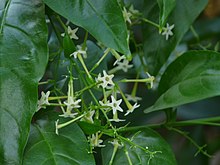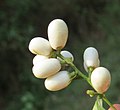
Atropa belladonna, commonly known as belladonna or deadly nightshade, is a toxic perennial herbaceous plant in the nightshade family Solanaceae, which also includes tomatoes, potatoes and eggplant (aubergine). It is native to Europe and Western Asia, including Turkey. Its distribution extends from Ireland in the west to western Ukraine and the Iranian province of Gilan in the east. It is also naturalised or introduced in some parts of Canada, North Africa and the United States.

Solanum dulcamara is a species of vine in the genus Solanum of the family Solanaceae. Common names include bittersweet, bittersweet nightshade, bitter nightshade, blue bindweed, Amara Dulcis, climbing nightshade, felonwort, fellenwort, felonwood, poisonberry, poisonflower, scarlet berry, snakeberry, trailing bittersweet, trailing nightshade, violet bloom, and woody nightshade.

Solanine is a glycoalkaloid poison found in species of the nightshade family within the genus Solanum, such as the potato, the tomato, and the eggplant. It can occur naturally in any part of the plant, including the leaves, fruit, and tubers. Solanine has pesticidal properties, and it is one of the plant's natural defenses. Solanine was first isolated in 1820 from the berries of the European black nightshade, after which it was named. It belongs to the chemical family of saponins.

Henbane is a poisonous plant in the nightshade family Solanaceae. Henbane is native to temperate Europe and Siberia, and naturalised in Great Britain and Ireland.

Nicandra physalodes is a species of flowering plant in subfamily Solanoideae of the nightshade family. It is known by the common names apple-of-Peru and shoo-fly plant. It is thought originally to have been native to western South America, including Peru, and is known elsewhere as an introduced and ruderal species – sometimes as a weed – in tropical, subtropical and, to a lesser extent, temperate areas all over the world. It has also long been cultivated as an ornamental plant for its attractive flowers and curious fruits and has been adopted into the traditional medicine of countries far-removed from its original home.

Solanum americanum, commonly known as American black nightshade, small-flowered nightshade or glossy nightshade, is a herbaceous flowering plant of wide though uncertain native range. The certain native range encompasses the tropics and subtropics of the Americas, Melanesia, New Guinea, and Australia.

Solanum nigrum, the European black nightshade or simply black nightshade or blackberry nightshade, is a species of flowering plant in the family Solanaceae, native to Eurasia and introduced in the Americas, Australasia, and South Africa. Ripe berries and cooked leaves of edible strains are used as food in some locales, and plant parts are used as a traditional medicine. Some other species may also be referred to as "black nightshade".
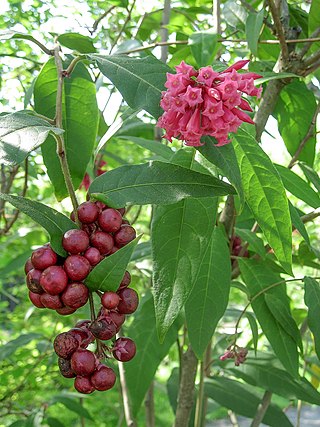
Cestrum is a genus of — depending on authority — 150-250 species of flowering plants in the family Solanaceae. They are native to warm temperate to tropical regions of the Americas, from the southernmost United States south to the Bío-Bío Region in central Chile. They are colloquially known as cestrums or jessamines.

Datura metel is a shrub-like annual or short-lived, shrubby perennial, commonly known in Europe as Indian thornapple, Hindu Datura, or metel and in the United States as devil's trumpet or angel's trumpet. Datura metel is naturalised in all the warmer countries of the world. It is found notably in India, where it is known by the ancient, Sanskrit-derived, Hindi name dhatūra (धतूरा), from which the genus name Datura is derived.
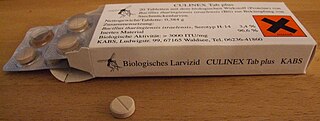
A larvicide is an insecticide that is specifically targeted against the larval life stage of an insect. Their most common use is against mosquitoes. Larvicides may be contact poisons, stomach poisons, growth regulators, or (increasingly) biological control agents.
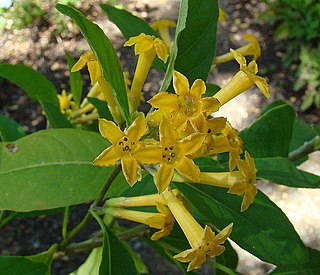
Cestrum parqui, commonly known as palqui, green cestrum, Chilean cestrum, green poisonberry, or willow-leaved jessamine, is a species of flowering plant native to Chile.

Cestrum fasciculatum is a species of flowering plant in the family Solanaceae known by the common names early jessamine and red cestrum. It is native to central Mexico, but it is also kept elsewhere as an ornamental plant. This is a gangly evergreen shrub reaching a maximum height of over two meters. The stems, and especially new twigs, are sometimes purple in color and slightly hairy. It bears hairy, oval-shaped, pointed green leaves up to 13 centimeters long. Plentiful inflorescences appear at the tips of stem branches, each a dense cluster of up to 10 hairy red flowers. Each tubular flower is 2 or 3 centimeters long, counting the elongated calyx of sepals and the long corolla. The fruit is a berry about 1.5 centimeters wide which is red on the outside and white inside with about 10 small brown seeds.

Iochroma arborescens is a species of flowering plant in the genus Iochroma, belonging to the nightshade family Solanaceae. Formerly it was considered the single species in the monotypic genus Acnistus. Common names include gallinero, mata-gallina, fruta-de-sabiá, hollowheart, wild tobacco, siyou, bastard sirio, galán arbóreo, tabaco de monte, nigüito, marieneira, güitite, and tabak djab.

Cestrum diurnum is a species of Cestrum, native to the West Indies. Common names include day-blooming cestrum, day-blooming jessamine, and day-blooming jasmine. Also known as Din ka Raja, in Urdu and Hindi. The scent of this quick-growing and evergreen woody shrub, often used for screens and borders, is released by day. Cestrum diurnum is easily propagated from the seed, which it produces in abundance.

Cestrum elegans, the purple cestrum, red cestrum, or bastard jasmine, is a species of flowering plants in the genus Cestrum.
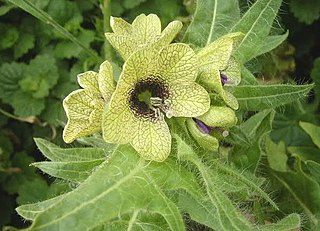
Hyoscyameae is an Old World tribe of the subfamily Solanoideae of the flowering plant family Solanaceae. It comprises eight genera: Anisodus, Archihyoscyamus, Atropa, Atropanthe, Hyoscyamus, Physochlaina, Przewalskia and Scopolia. The genera Archihyoscyamus, Atropanthe and Przewalskia are monotypic, the first being endemic to Turkey and Iran, the second to China and the third to Tibet.

Vestia is a monotypic genus of flowering plants in the family Solanaceae containing the single species Vestia foetida (syn. V. lycioides). Its principal common names in the Mapudungun language of its native Chile are Huevil (pron. "wayfil" and sometimes redoubled Huevilhuevil) and Chuplín. Other Chilean names include Chuplí, Echuelcún and Palqui (negro) (this last being also applied to Cestrum parqui), while an English common name Chilean box thorn has also been coined recently in reference to a certain similarity of the plant to some species in the box thorn / wolfberry genus Lycium (as referenced also in the former specific name lycioides, meaning "Lycium-like"). Vestia foetida is endemic to central and southern Chile, being found in an area stretching from the Valparaíso Region in the north to Chiloé Island (in the Los Lagos Region) in the south. Growing to 2 m (7 ft) tall by 1.5 m (5 ft) broad, it is an evergreen shrub with glossy, privet-like, mid-green leaves. In spring and summer it bears tubular yellow flowers to 3 cm (1 in) long, with stamens so markedly exserted (= protruding) as to recall those of certain Fuchsia species, followed by 4-valved, ovoid capsules to 1 cm (0 in), containing small, prismatic seeds.

The Solanaceae, or the nightshades, are a family of flowering plants that ranges from annual and perennial herbs to vines, lianas, epiphytes, shrubs, and trees, and includes a number of agricultural crops, medicinal plants, spices, weeds, and ornamentals. Many members of the family contain potent alkaloids, and some are highly toxic, but many—including tomatoes, potatoes, eggplant, bell and chili peppers—are used as food. The family belongs to the order Solanales, in the asterid group and class Magnoliopsida (dicotyledons). The Solanaceae consists of about 98 genera and some 2,700 species, with a great diversity of habitats, morphology and ecology.

A moon garden, also known as a twilight garden, evening garden, night garden, moonlight garden, or dream garden, is a type of garden designed to be enjoyed at dusk and nighttime. Fragrant flowers, light-colored vegetation or blooms that are visible by moonlight, blossoms that open at night instead of day, and plants which attract night pollinators you can hear, are all elements of a moon garden. The different effects produced by moonlight compared to sunlight in human color perception emphasize the colors of certain flowers more than others, bringing out different tones which are not available during daytime or with artificial lights. Night-blooming plants are typically moth, bat or wind pollinated. Planning an evening garden can perform double-duty as a setting for evening entertaining such as barbecues and parties.
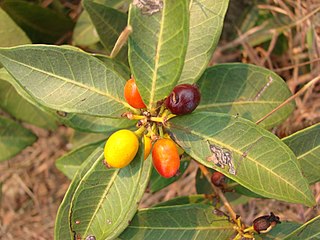
Eugenia calycina, also known as savannah cherry, field cherry, Jabuti cherry, Grão de galo, cerejinha, cereja do cerrado, pitanga-vermelha, red pitanga, cherry of the Cerrado, and ca-ajaboti, is a flowering shrub in the family Myrtaceae. The specific epithet (calycina) comes from Latin calycinus, meaning having a notable calyx.
